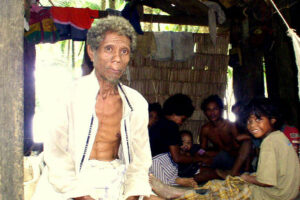Many years ago, while on a research assignment on ancestral domains, I was scheduled to interview a tribal leader in Esperanza, Agusan del Sur. While waiting for him, I was shocked and saddened to learn that he had just been assassinated while exiting a Catholic Church where he had attended a baptism.
Another tribal leader then kindly guided me up a mountain where I encountered the most utterly miserable people I had seen in my life. They were members of a tribe called Mamanwa (people of the forest). They had dark skin paled by obvious malnutrition; and they had very curly hair. They looked to me like the aborigines of Papua New Guinea.
While there, I was able to have a conversation with a widow of about 30 years old. Although she said they had their own language, she told me they also spoke and understood Cebuano. She said that according to their history which they learned in songs passed on through generations, they came from far away. They had originally settled in the lowlands but had to continue to move toward the uplands as other settlers who came by sea, whom they called “dinagats” took over the lowlands. The men around us squatted and just watched shyly as we talked. They did not seem to have enough energy to stand or walk around. The widow told me she could not leave their little settlement as she had to help her sister, whose legs were swollen (obviously from kwashiorkor) and could not walk to the areas where they conducted their personal hygiene.
The widow told me that when she married someone from another tribe, she had to move to his community. However, when he died, following tradition, she had to move back to her parents’ community. When she returned, she discovered that she could not harvest coconuts from her late father’s farm because someone had obtained a title to their ancestral land. She had to climb trees at night to virtually “steal” coconuts from trees planted by her late father so she and her sister could have something to eat.
To obtain water, they had to go down to the lowlands as the water sources in their settlement had dried up when most of the trees were cut down by loggers. On the way up the mountain, I had noticed signs saying “Chainsaw for rent.”
The Mamanwas no longer had land on which to farm, and no access to forest products and wild animals which they could turn into food. Once in a while, someone (probably from an NGO) would come to bring them food. It was a depressing experience for me. More depressing when I consider the millions stolen from collected taxes (including the much-abused multibillion-peso PDAF which it seems no one has had to pay back).
I think of the Mamanwa whenever I see Ferraris and Porsches on our streets in the city. How can we have fellow Filipinos living that way?
A recent report prepared by World Bank staffers with assistance from external sources such as the National Economic and Development Authority (NEDA) and the Philippine Statistics Authority (PSA) reveals that between 1985 (the end of the Marcos Senior era) and 2018 following the presidencies of Gloria Arroyo and Benigno Aquino III, poverty in the Philippines had decreased from 49.5% to 16.7%. The middle class also expanded during the same period, probably helped by business process outsourcing salaries and increased wages of cops, soldiers, and teachers. However, the gains were reversed by the pandemic when many jobs were lost and small businesses folded. As the economy normalizes, it is expected that the gains can be at least partially recovered.
The report also significantly reveals that grants in aid from the government, such as the 4Ps and other subsidies for the very poor, also helped reduce food poverty. This has made a critical difference as malnutrition reduces mental capacities for learning.
Meanwhile, the World Bank report also discloses that the Philippines had one of the highest income inequality rates in East Asia. The wealthiest 1% of earners capture 17% of national income; all those in the bottom 50% collectively receive only 14%. Access to adequate nutrition, quality education, safe water, and equitable opportunities make a big difference. The international poverty line is set in the World Bank study at $2.15 per person per day using 2017 prices. This means that anyone living on less than $2.15 a day is in extreme poverty. About 648 million people globally were in this situation in 2019.
There are, of course, variations in the statistics by region. The most severely impoverished is of course the BARMM (Bangsamoro Autonomous Region of Muslim Mindanao). Poverty in this region was reported to be at 62% in 2018! Obviously, much work needs to be accomplished here. In general, poverty reduction in Mindanao is slower than in other regions. This indicates the need to redistribute government investments. It will also help if statistics on poverty and inequality are gathered regularly on a provincial, not just regional level.
Meanwhile, we continue to invest heavily in the Metro Manila region, building overhead trains, skyways, and now underground railways (subways). Thus, we continue to attract investors into “Imperial Manila” and thereby continue to increase its population and to exacerbate its traffic and environmental problems.
It is a good thing the Mandanas bill will increase LGUs’ share in the national budget. This should help strengthen the responsiveness of government to the needs of the people. Better infrastructure in the provinces can also increase private sector investments and generate more jobs. LGU executives are closer to the problem of poverty and extreme inequality. Hopefully, extreme poverty situations such as those faced by the Mamanwas can more effectively be prevented.
Teresa S. Abesamis is a former professor at the Asian Institute of Management and fellow of the Development Academy of the Philippines.
